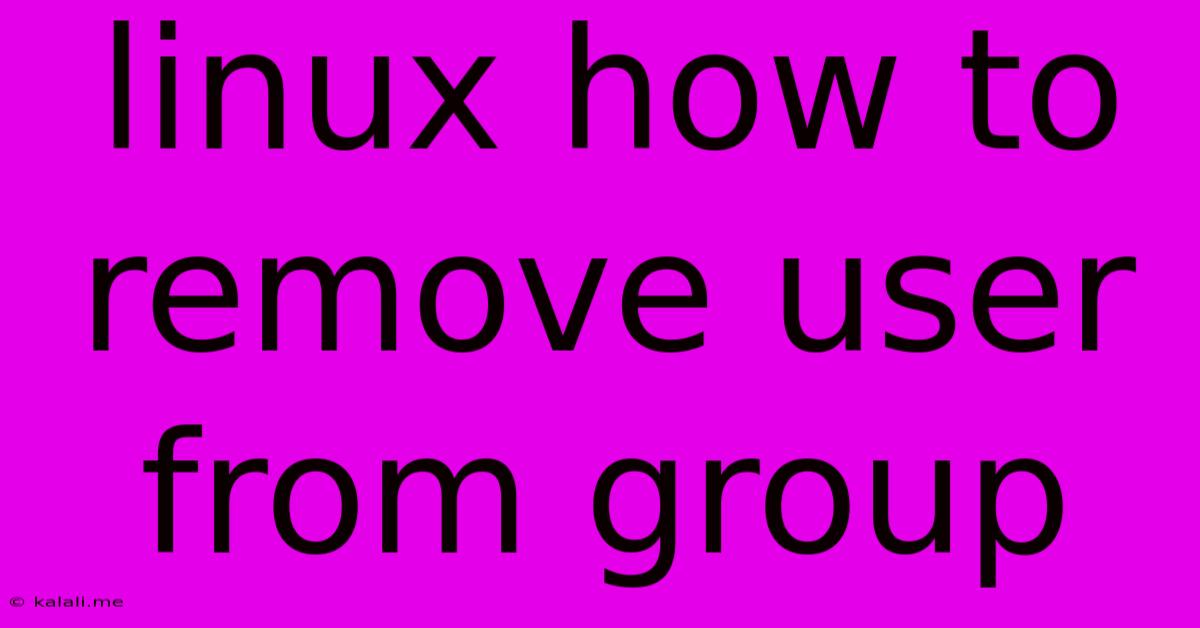Linux How To Remove User From Group
Kalali
May 24, 2025 · 4 min read

Table of Contents
How to Remove a User from a Group in Linux: A Comprehensive Guide
Removing a user from a group in Linux is a common administrative task, crucial for managing user permissions and security. This guide provides a comprehensive walkthrough, covering various methods and addressing common scenarios. Understanding group management is vital for maintaining a secure and efficient Linux system. This process ensures that users only have access to the resources and privileges necessary for their roles.
Understanding Linux Groups and User Permissions
Before diving into the removal process, let's briefly review the fundamental concepts. In Linux, users are organized into groups. Groups provide a convenient way to manage permissions for multiple users simultaneously. A user can belong to multiple groups, inheriting the permissions associated with each. Removing a user from a group revokes their access to resources controlled by that group. This is a key aspect of security best practices, limiting potential vulnerabilities.
Methods to Remove a User from a Group
There are several ways to remove a user from a group in Linux, each offering slightly different approaches depending on your comfort level and system configuration.
1. Using the gpasswd command:
This is arguably the most straightforward and recommended method. The gpasswd command is specifically designed for managing group membership.
-
Syntax:
sudo gpasswd -d <username> <groupname> -
Explanation:
sudo: Elevates your privileges to perform the administrative task.gpasswd: The command for group password management.-d: Specifies the delete option, removing the user from the group.<username>: The name of the user to be removed.<groupname>: The name of the group from which the user will be removed.
-
Example: To remove the user
johnfrom the groupwheel, you would use:sudo gpasswd -d john wheel
2. Modifying the /etc/group file directly (Advanced Users Only):
This method involves directly editing the /etc/group file, which contains the list of groups and their members. Caution: This approach requires careful attention to detail; incorrect editing can lead to system instability. It's generally recommended to use the gpasswd command instead.
-
Process:
- Open the
/etc/groupfile using a text editor with root privileges (e.g.,sudo nano /etc/group). - Locate the line corresponding to the group you want to modify. The format is
<groupname>:<GID>:<password>:<comma-separated list of users>. - Remove the username from the list of users.
- Save and close the file.
- Open the
-
Important Note: After modifying the
/etc/groupfile, you might need to refresh the system's group information. This can usually be achieved by logging out and back in, or by restarting the system. This step ensures that the changes take effect correctly. Remember to always back up the/etc/groupfile before making any manual changes.
3. Using a graphical user interface (GUI):
Many Linux desktop environments provide graphical tools for user and group management. The specific method varies depending on the desktop environment (GNOME, KDE, XFCE, etc.). These tools typically offer a more user-friendly interface, simplifying the process for users less comfortable with command-line interfaces. Consult your desktop environment's documentation for instructions on managing groups through the GUI. This often involves navigating to system settings and managing users and groups visually through an intuitive interface.
Verifying the Removal:
After removing the user from the group, it's crucial to verify the change. You can do this using the groups command:
-
Syntax:
groups <username> -
Example:
groups johnwill list the groups to whichjohncurrently belongs. If the removal was successful, the specified group will no longer be listed.
Troubleshooting Common Issues:
- Permission Errors: If you encounter permission errors, ensure you're using
sudoto run the commands. - Typographical Errors: Double-check the usernames and group names for any typos. Even a small mistake can prevent the command from working correctly.
- Incorrect File Permissions: If you edit
/etc/groupmanually, ensure you have the correct file permissions set after saving changes.
By following these steps and understanding the underlying concepts, you can effectively manage user groups and maintain a secure Linux environment. Remember that proper user and group management is crucial for system security and stability. Always prioritize best practices and avoid making unnecessary changes without a clear understanding of their implications.
Latest Posts
Latest Posts
-
How Many Cups Is 1 Pound Of Cheese
Jul 12, 2025
-
30 X 30 Is How Many Square Feet
Jul 12, 2025
-
How Much Does A Half Oz Weigh
Jul 12, 2025
-
Calories In An Omelette With 3 Eggs
Jul 12, 2025
-
How Do You Say Great Grandmother In Spanish
Jul 12, 2025
Related Post
Thank you for visiting our website which covers about Linux How To Remove User From Group . We hope the information provided has been useful to you. Feel free to contact us if you have any questions or need further assistance. See you next time and don't miss to bookmark.